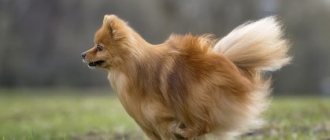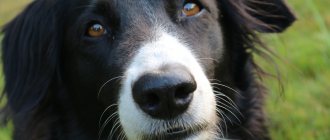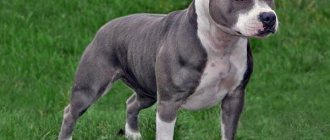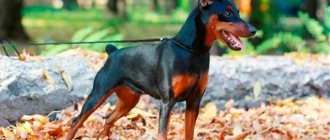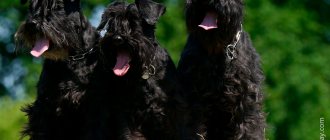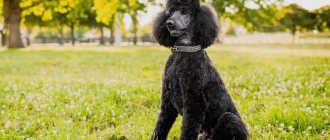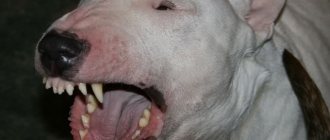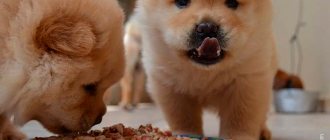Intelligence is not a line with border collies at one end and stupid dog breeds at the other. In reality, memory or navigation, cause-and-effect reasoning or inference are all different areas, and different breeds will have strengths in one area or another, or a combination of them.
According to Liz McHaffie, a professional dog trainer and behaviorist, most dogs that people consider smart are breeds that work closely with people. These dogs are much more likely to be oriented towards us and motivated in their social interactions with us. In other words, the dog breeds that people often consider smarter than others enjoy being around humans more.
But on the other hand, “dumb” dog breeds are more independent dogs. They're not necessarily less smart—they're just good at other things that people overlook or don't fully understand. Here are nine of the dumbest dog breeds that actually seem that way.
Basset Hound
- Origin: UK
- Height: from 28 to 38 cm
- Weight: from 20 to 29 kg
- Life expectancy: 10-12 years
- Personality: meek, obsessive, stubborn, friendly, loyal, affectionate
People often think that Basset Hounds are not a very smart dog breed because they don't have as much energy as beagles and can be easily distracted by smells . But Basset Hounds excel at what they were bred for: tracking down even the smallest tracks. They can also be trained with the right amount of food motivation.
Veterinarians note that some dog breeds with long backs and short legs may experience problems with the spine and joints; this can affect their ability to learn and concentrate.
How to test your pet's intelligence
A dog's mental abilities are assessed using basic tests that require a stopwatch.
Test 1. The dog is asked to find a treat lying on the floor and covered with a towel. Depending on how long the search takes, the dog gets a certain number of points:
- up to 30 sec. – 3;
- 30–60 sec. – 2;
- more than 60 sec. - 1;
- the animal made no attempt to get the treat – 0.
Test 2. The dog is offered to get a treat hidden under a low sofa. The number of points is also calculated depending on the time it takes the dog to retrieve the treat using its paws:
- 2 minutes – 4;
- 3 minutes – 3;
- failed to reach with paws in 3 minutes – 2;
- tried to catch it with her teeth – 1;
- refused to complete the task – 0.
Test 3. Cover the dog’s head with a towel and estimate how long it will take the dog to get out:
- up to 30 sec. – 3;
- 30–120 sec. – 2;
- the attempt was unsuccessful – 1;
- no attempts – 0.
Test 4. The dog is asked to find a treat hidden under one of three bowls, and the result is also assessed by weight in points:
- I immediately found something tasty – 2;
- after 2 minutes – 1;
- did not cope with the task - 0.
Then they calculate the total number of points and draw conclusions:
- 10–12 – the dog is endowed with outstanding mental abilities;
- 8–10 – the dog has developed intelligence;
- 4–7 – the dog’s mental abilities at medium damage;
- 1–3 – either the animal is very stubborn, or no one trained it;
- 0 points – the dog is left to his own devices from puppyhood.
Afghan Hound
- Origin: Afghanistan
- Height: from 60 to 74 cm
- Weight: from 26 to 34 kg
- Life expectancy: 12-14 years
- Personality: dignified, aloof, independent, curious
a "predatory streak" in Afghan hounds , similar to hounds. Retrievers, for example, search for prey shot by a hunter and bring it back intact. Afghan hounds were bred to independently sniff out, catch and bring prey to their owner.
Many people think that Afghan Hounds' independence and energy implies they have a low level of intelligence, but perhaps only if you define intelligence as being dependent on people and interested in their praise.
Basenji
This African non-barking dog is known for its independence and aloofness.
Some people describe the breed as having cat-like qualities, and in fact many Basenjis paw-wash themselves like cats. Basenji dogs have earned a reputation for being "unmanageable," but in this case, ease of training is not always an accurate indicator of intelligence. On the contrary, these animals are smart, curious and playful. They have excellent hunting qualities and are still used for hunting in the Congo.
Training a Basenji can sometimes feel like taming a wild animal. They are vigilant and careful, and also fearless and very stubborn. You cannot educate them with a stick, only with patience and affection.
Beagle
- Origin: UK
- Height: from 33 to 41 cm
- Weight: from 9 to 11 kg
- Life expectancy: 12-15 years
- Personality: decisive, emotional, affectionate, friendly, balanced
Beagles often make lists of the dumbest dogs because they are bloodhounds that are easily distracted and difficult to train due to their stubbornness . Much of the knowledge that experts have today about canine cognition and cognitive dysfunction comes from studies of beagles.
Dog trainers point out that we should not disparage the intelligence of sniffer dogs when they follow their noses, because they are simply doing what we created them to do. Smell is incredibly important to dogs, so being distracted by smells is a natural instinct in beagles that is difficult to suppress.
Criteria by which a dog's intelligence is determined
Assessing animals for survival skills or performing complex tasks is extremely difficult. Therefore, experts take a simpler path - they evaluate only two factors related to the commands given by the owner.
The first is the number of repetitions required for the dog to understand the command. The stupidest dog begins to understand it after 80-100 repetitions, but for the smartest, this figure does not exceed 5. Secondly, the number of cases when the dog carries out the received command the first time is taken into account. For the TOP 10 smart breeds, this figure is 95%. But there are those for whom it rarely exceeds 25%.
Bulldog
- Origin: UK
- Height: from 31 to 40 cm
- Weight: from 18 to 25 kg
- Life expectancy: 8-10 years
- Personality: flexible, sociable, capricious, friendly
Bulldogs are often teased as being the dumbest because they can be stubborn and difficult to train. Part of the reason for this behavior is that selective breeding has resulted in bulldogs having the most numerous and complex health problems of any dog breed. Bulldogs are brachycephalic dogs with flat faces that cause breathing problems. Additionally, wrinkled facial skin may be predisposed to bacterial infections and other skin problems. All of these reasons make it difficult for Bulldogs to concentrate and learn commands or compete effectively.
Bulldogs have a really stocky, barrel-shaped body, short legs and a flattened face - all of which make it difficult for them to excel in exercise because that's how their body is designed. So it's not that bulldogs are less intelligent - they just may have a hard time getting around, let alone learning new tricks. They are trainable, but be a little lenient with them.
TOP 10 least intelligent dog breeds
The stupidest dog breeds are an unflattering epithet and an offensive rating. It would be more accurate to say that certain breeds are less intelligent than others. They are less obedient, unable to remember and carry out even the simplest commands. Often the dogs themselves are smart, but due to the owner’s inattentive attitude and lack of proper education, they give the impression of being uncontrollable and capricious.
Because of its stubbornness, the Pekingese often tops all sorts of ratings of stupid people in the dog world.
Pekingese
The second name of the dog breed is the Peking Lion Dog. The homeland of these small dogs is China, where they were revered and were an essential element of the life of the royal court. The original attractive appearance is the main reason that representatives of the breed quickly earned popularity all over the world. However, it is the Pekingese that tops the ranking of the stupidest dogs because of its amazing stubbornness.
It is difficult to force a representative of the breed to follow a command; he is willful and lazy. Often pretends that he does not hear the owner, although in fact he simply ignores him.
Bulldog
Bulldogs are considered to be smart and quick-witted dogs. But they are phlegmatic and lazy, extremely reluctant to undergo training, and do not like to follow the owner’s commands. Therefore, they unfairly earned the nickname of stupid people. Passive dogs do not tend to spend time outdoors, preferring the sofa or the comfortable lap of their owners.
The only function this pet can perform is to be a companion. He will not be able to protect his home or herd, help in hunting or serve, so you should not expect much success from the dog. But as companions, bulldogs are really good. They get along well with children and adults, do not require special care, are peaceful and good-natured.
Note! If the bulldog's stubbornness and passivity do not frighten the potential owner, then the friendship between man and dog can last for many years.
The bulldog's phlegmatic and laziness has led some to question their mental abilities.
Bloodhound
The reason why this purebred dog is included in the list of fools is simple - he is incredibly stubborn. The dog is not at all interested in training and following commands; it is ready to frolic and play all day long, completely oblivious to the needs of its owners. This is why the Bloodhound is a very stupid dog, according to many.
Note! These are active, dynamic dogs that need free space and the opportunity to run around. Living in an apartment is an excellent opportunity to learn the most negative qualities of a Bloodhound.
Chow chow
The bear dog, with golden fur and a blue tongue, also does not shine with intelligence. She is able to master several basic commands and often performs best at exhibitions. But she is not capable of carrying out complex tasks. An aristocratic, proud dog will never bring back a stick or Frisbee thrown by his owner; his interests do not extend to overcoming obstacles and exploring difficult routes.
The original purpose of the Chow Chow is watchdog activity, but due to the stubborn, quarrelsome nature and unwillingness to obey the orders of the owner, representatives of the breed do not make good watchmen.
Note! Many people want to become the owner of this charming creature, but the Chow Chow is only suitable for experienced dog handlers with an iron fist. Only they will be able to properly raise and socialize the dog.
Beautiful Chow Chows are not known for their obedient disposition.
Basset Hound
The dog with surprisingly sad eyes and drooping ears is often a participant in the top lists of the most intellectually poor dogs. The reason is simple - the slowness of the animal, which in some cases is mistakenly recognized as stupidity. In fact, the basset understands from the first time what they want from him. But he thinks in detail about how best to execute the required command. Time passes, the impatient owner begins to get nervous and doubt the pet’s intelligence, but he is still making a decision.
Representatives of the breed are phlegmatic, so they will become wonderful companions for older people. For active young people, such a pet is undesirable, since differences in temperament and lifestyle will cause misunderstandings.
Afghan Hound
The dumbest dogs - this is the non-forest nickname that these elegant, fit animals have earned. The reason is simple - they are stubborn. At the genetic level, greyhounds are accustomed to independence, so giving a paw at the owner’s first request is meaningless and insulting for them. To those who own greyhounds exclusively for hunting, they seem to be the embodiment of intelligence and intelligence.
Note! If the goal of purchasing a puppy is to get a living toy, uncomplaining and trouble-free, then you should pay attention to another breed. Greyhound representatives will not do anything they don’t see the point in.
Shih Tzu
This is a charming fluffy dog that arrived from China and quickly earned the love of dog handlers around the world. However, keeping a representative of the breed is fraught with difficulties. Only early socialization and strict training can turn a Shih Tzu into a normal pet. If you let go of the “reins of power,” there is a high risk that the animal will become uncontrollable. That is why you should not get such dogs in the following cases:
- In the absence of experience.
- If there is no free time for training and socialization.
- If you don't have confidence in your own abilities.
A dog cannot be called stupid in the literal sense of the word, but by dog standards it is far from at least an average level of intelligence due to its pronounced stubbornness. The animal initially perceives its owner as an equal; in addition, it gets along very poorly with children and can bite or claw painfully, not caring at all about the consequences.
English bulldog
Another phlegmatic sloth who made the list because of his amazing passivity and unwillingness to do anything. This good-natured lump is not distinguished by grace, does not strive for active games, prefers a quiet rest on his sun lounger. He is extremely reluctant to follow commands and is completely indifferent to dog toys. That is why his intellectual abilities were questioned.
However, the animal dotes on its owner and will never forgive him for separation. Those who are not sure that 15-18 years old can be his friend should not get a bulldog.
Russian greyhound
Like the Husky breed, these animals began to be called stupid because of their strong character and unwillingness to obey. In the wild, these traits of predators would benefit them, but for humans they indicate that the pet’s intelligence is not sufficiently developed.
Like the Afghan, the Russian greyhound is disobedient and willful, which is why it is not considered a smart dog
Greyhounds will not obey commands without complaint, they hate training, and they require a special approach. They will not repeat the same action several times. That is why rumors about their “stupidity” arose.
Note! Greyhounds need an experienced owner who is willing to take an unconventional approach and turn training into an exciting game. It is unacceptable to use physical violence against a dog.
Beagle
The baby beagle is the “dumbest” dog in the world, as some are sure. An ill-mannered puppy quickly turns into a hyperdynamic, uncontrollable dog that does not consider it necessary to obey its owner. The solution is simple - raise the dog literally from day one or abandon the breed in favor of a calmer and more submissive one.
Pekingese
- Origin: China
- Height: from 15 to 23 cm
- Weight: from 3.2 to 6.4 kg
- Life expectancy: 12-15 years
- Personality: obsessive, willful, stubborn, good-natured
Pekingese, like bulldogs, have flat faces and can suffer from the same breathing problems. They are also not the easiest dogs to train, and they are not big fans of exercise . This is primarily due to the fact that they were created for communication, and not for sports.
This is not a working, but a decorative breed of dog. Their job is to just hang out with their people, sit on their laps, and be a nice dog. And Pekingese do this quite well, which makes them geniuses in the areas of “looking cute” and “hugging tenderly.”
Shih Tzu
At first glance, dogs of this breed resemble plush toys, which is not so far from reality. These are small animals with luxurious fur, long flowing strands, different colors (most often light or reddish) and a cute face. The breed is classified as decorative and is extremely difficult to train, which is due to the long history of its origin.
Shih Tzus were bred for beauty, not intelligence.
Shih Tzus were bred specifically for representatives of royal families back in the Ming Dynasty, and their main function was to recline with a languid look on pillows, calmly enduring the affection and hugs of their owner. They did not require the ability to follow commands and obey, so modern descendants of the royal Shih Tzu are not distinguished by high intelligence. But they are great as a sweet and kind pet, they are practically non-aggressive, and are great for those who want to have a living, beautiful toy and agree to look after it.
Chihuahua
- Origin: Mexico
- Height: from 15 to 23 cm
- Weight: from 1.8 to 2.7 kg
- Life expectancy: 12-20 years
- Personality: aggressive, loyal, lively, agile, vigilant, courageous
Chihuahuas have big personalities, which means they will resist if you try to force them to do something they don't want to do. Owners of these Mexican dogs should train them from an early age to prevent the development of destructive behavior . However, as practice shows, many owners do not worry about this because they believe that Chihuahuas are too small and cannot create serious problems.
In fact, Chihuahuas often have behavior problems, usually due to stress. In part, they are considered less intelligent “because they are prone to fear.” Fear also prevents them from learning or responding to commands. We perceive information best when we are relaxed. When our brains are stressed, it pushes us into fight or flight mode and actually shuts down the part of the brain that helps us think critically and learn.
When it comes to Chihuahuas, we often think of them as stupid pets, and this may just be some sort of behavioral response to stress.
Toy Terrier
The Toy Terrier is a small dog that is afraid of everything. And it is because of her fear that she does a lot of stupid things. In a panic, jump a couple of meters and break your paw? Easily. Frightened by the noise, turn the bowls over on yourself? Nothing could be simpler. Owners of toy terriers need to constantly protect and calm their pet, otherwise this panicker will harm himself.
I decided to teach my wife’s toy terrier at least some commands. But after two weeks of ordeal, he realized that his memory is not enough even for 3 commands, he constantly confuses everything. And what’s even worse is that in response to a stern commanding voice (quiet, without threats), the dog begins to shake and pee in fear.
roman1982
https://irecommend.ru/content/ochen-glupaya-sobaka-ne-dlya-zhenshchin-kotorye-khotyat-syusyukatsya
The toy terrier is an active dog, but it spends all its energy in a couple of minutes, and then gets tired and reaches out for its owner’s arms.
English Mastiff
- Origin: England
- Height: from 70 to 91 cm
- Weight: from 54 to 100 kg
- Life expectancy: 6-12 years
- Personality: good-natured, obsessive, dignified, protective, brave, calm
People mistakenly believe that English Mastiffs are not very intelligent because they are too calm and calm . They have physical characteristics that may make people think that they are not that smart. But these assumptions are only based on what English Mastiffs look like or how quickly they react to something, although this is not a very good indicator of intelligence.
Siberian Husky
A beautiful dog, similar to a wolf, but gentle and friendly with almost all people.
Husky loves the outdoors and needs to travel every day. He is smart, but free-spirited and independent, which makes training a Husky a challenge. Very often, huskies run away from home, and with incomprehensible cunning they even manage to free themselves from their leash. And they can easily jump even over a high fence.
Leaving a husky alone without communication, physical and mental stress is a sure way to return to a house destroyed from walls to floors.
Bloodhound
- Origin: France, Belgium, UK
- Height: from 58 to 69 cm
- Weight: from 36 to 50 kg
- Life expectancy: 10-12 years
- Personality: stubborn, cold-blooded, obsessive, affectionate
Bloodhounds were bred to be more independent. People often think they are stupid for a variety of reasons: they have the funny appearance of a mastiff or basset hound; They are easily distracted by scents , just like other hounds. But again, Bloodhounds are simply doing what they were originally bred to do. The bloodhound picks up the trail and purposefully leads the owner to the source.
Bloodhounds were bred to be able to pick up tiny scents and follow them for miles, and they are very good at their job. If you measured intelligence by sniffing skills, these short-legged dogs would be geniuses. But if you compare Bloodhounds to Labradors, for example, and expect them to constantly be near you and fetch things on command, they may disappoint you.
Border Collie
The smart dog was specially bred with the indicated parameters. Among domestic dog breeds, border collies are the smartest! Confirmed by breed breeders, outside observers, dog handlers, and breeding establishments. Dogs have a number of advantages:
- medium size, allowing you to get a dog outside the city, in urban conditions;
- noticeable activity makes the owner mobile - important in modern society;
- the highest ability to learn will facilitate the process of training and education;
- life expectancy – 16 years;
- suitable as a gift for a teenager over 12 years old;
- gets along with the owner's family, children, animals, strangers;
- companion, pet, sheep shepherd in villages, villages.
Let us note complex nuances for the owner. You will have to constantly take care of your pet's fur. The coat is the pride of the border collie! You need to bathe your pet up to 4 times a year. If you are not ready to show mobility, play, run with the dog, walk at least a couple of hours a day - do not take a closer look at the described breed. Suitable for active people who love guests, sports, family walks, and outings.
Chow chow
- Origin: China
- Height: from 46 to 56 cm
- Weight: from 20 to 32 kg
- Life expectancy: 9-15 years
- Personality: independent, calm, aloof, loyal
The Chow Chow is often described as an "alpha male wannabe" who may resist training simply because he is very stubborn . According to the American Kennel Club, Chow Chows were originally bred for a variety of purposes, including guarding, transportation and hunting.
However, don't let the stubbornness of these Chinese dogs fool you; they are not stupid, they just want to defeat you without using force.
Golden retriever
The large breed will not leave anyone indifferent. The attractive dog has luxurious fur that seems to shimmer in the sunlight. The difficulty in keeping a pet is caring for the pet's hair. It's hard at first, but then you get used to it. The Golden Retriever is a hunter by nature. They love water, swim, and are happy to keep company in the river or pool. Obedience courses are better - basic, advanced standard.
- The breed is friendly and good-natured.
- Dogs are confident and easily make the necessary decisions.
- They love children and are patient with their antics and behavior.
- Suitable for children over 11 years old for independent education.
- They easily find a common language with strangers and play with them.
- Training seems to be the simplest, because the pet tries to please the owner.
- They live on average up to 13 years.
- They need bathing 2 times a year. A haircut is needed regularly.
- Monitor the condition of your ears - there is a tendency to become infected.
- Intelligence is in the blood - don’t take them as guards, they don’t even bark much.
- Suitable for hunting, for official purposes (search and rescue), for helping the blind (guides).
Dachshund
The smartest burrowing dogs strive to be leaders in everything. This also applies to relationships with the owner. Dachshunds understand perfectly well what their owners require of them, however, they have their own opinion on each situation. These little shrews only do what they want. The muscular body allows you to hide from the owner’s anger in time and avoid punishment. They can be aggressive towards strangers and animals.
How can you choose a dog and not make a mistake?
There are breed selection tests. And based on the personality characteristics, financial capabilities, amount of free time and aesthetic preferences of the owners, you can quite accurately determine what breed of dog he should get. It is difficult for an ignorant person to distinguish which behavioral features are determined by genetics and which are formed during life. But even if you adopted a dog, and then came across something that doesn’t suit you very much about it, or you fell in love with some breed in absentia, but don’t really understand how to live with it, all problems can be solved within the first of the year. Correct shortcomings in upbringing, expand breed restrictions, or, on the contrary, prevent something from developing. Dogs are not very different from people in this sense. A one-year-old dog is a sixteen-year-old teenager, and it is very important to have time to put into his personality everything that we hope to see in him.
CAVALIER KING CHARLES SPANIEL
- Dog breeds / small / for apartments / do not bark
Photo: Bigandt_Photography/Getty Images
Cavalier King Charles Spaniels are not known to bark. But this happens if the dog craves attention or feels neglected. The Cavalier King Charles Spaniel may bark due to anxiety, fear, loneliness or separation anxiety.
MORE DETAILS
Add to cart
Quick view
Compare
Close
CeramikArt ceramic box for storing dog treats white
450,00 ₽
Add to cart
Quick view
Compare
Close
Ceram bowls in der Trixie black
2 850,00 ₽
SHARPEI
- Dog breeds / medium / smart / for apartments / guard / do not bark
Photo: zokov/Getty Images
Shar Peis bark very rarely. This is an ideal choice if you prefer a calm breed. Shar Peis are a strong, loyal and loving breed of dog. These "Chinese" maintain a zen-like calm unless they sound the alarm about a potential threat.
MORE DETAILS
Ekaterina Varnava, Olga Orlova, Michelle Pfeiffer published touching zoo photos on Instagram
JAPANESE CHIN
- Dog breeds / small / for apartments / do not bark
Photo: Niconic_Photography/Getty Images
The Japanese Chin is not prone to barking. This is a family breed, calm and pleasant, and gets along well with children. They are often compared to cats because chins love to rest on their owner's lap. These dogs may bark from separation anxiety or if they have been neglected.
MORE DETAILS
GERMAN DOG
- Dog breeds / large / for protection / guard / do not bark
Photo: Earl-Wilkerson/Getty Images
Great Danes are a breed of gentle giants known for being highly protective of their home and loved ones. This is one of the quietest breeds. They rarely bark unless there is a good reason: to warn of danger, for protection, to greet, or out of boredom if they are ignored or left alone for too long.
MORE DETAILS
Add to cart
Quick view
Compare
Close
Hunter dog harness Tripoli nylon St. pink, reflective
850,00 ₽
Add to cart
Quick view
Compare
Close
DARELL Synthetic reflective collar “ECO-LUMI” 20mm 32-41cm
200,00 ₽
German Shepherd
The most significant genetic disorders: degenerative myelopathy, exocrine pancreatic insufficiency, hemophilia, hip dysplasia, renal cystadenocarcinoma and nodular dermatofibrosis, pannus/chronic superficial keratitis, panosteitis, perianal fistula.
The loyal and courageous German Shepherd has been a very reliable dog for many generations. Shepherds are descended from German herding dogs and were used on farms for a long time before becoming popular as police dogs and other working dogs. Although they are very strong, fast and agile, their health is also subject to careful monitoring, due to their tendency to certain diseases.
A disorder that affects many German Shepherds is degenerative myelopathy, a progressive disease of the spinal cord that eventually causes paralysis. Additionally, hip dysplasia, which also affects mobility, is a common condition in this breed.
Doberman and Rottweiler: the bomb is on edge
Tatyana, Zelda’s former owner, and Nikita, Nash’s owner: “We had to give away six-year-old Zelda after she, apparently in a fit of jealousy, bit my one-year-old daughter. They say that if a Rottweiler gets angry at a person at least once, he will repeat this trick.
- And when Nash appeared, guests stopped coming to us. It’s annoying when you bend down to pick up a fallen fork, and they growl at you expressively. Yes, this is an excellent guard. But he himself decides when the owner is in danger.
Doberman and Rottweiler
Zoopsychologist: - The Rottweiler is known as the “butcher’s dog” - it guarded merchants’ shops from robbers, without encroaching on steaks. It starts up slowly, but once it starts up, it's hard to get it to stop.
As for the Doberman, it is unknown which mongrels the amateur breeder Carl Louis Doberman used when he bred the “dog for a traveling salesman.” And this creates problems. At the slightest mistakes in training, the dog becomes extremely nervous.
